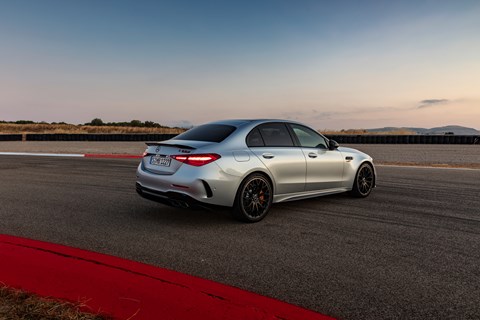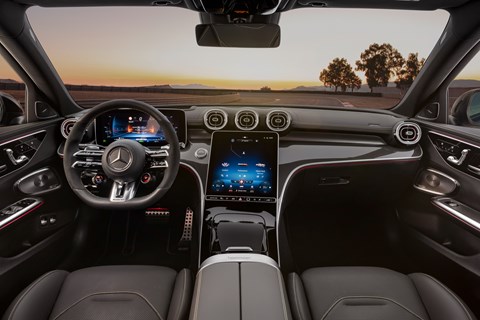- Complex plug-in-hybrid 2.0-litre four replaces V8
- Estate and saloon versions available
- Stepping stone on way to full-electric AMG
Mercedes has revealed the new C63, a C-Class-based saloon and estate making a total of 670bhp and 752lb ft from its high-tech petrol-electric hybrid powertrain. With all-wheel drive and rear-wheel steering, the new C63 has a 0-62mph time of 3.4sec, down from the previous car’s 4.0sec, and a top speed of 174mph for the saloon.
The plug-in hybrid system is there to boost performance, not to save the planet or offer significant electric-only driving range – the official figure is only eight miles, and the CO2 emissions are a hefty 156g/km.
It’s much more potent and more technically advanced than the new C43 mild hybrid, and in fact shares much of its technology with the V8-engined GT63 S E Performance. AMG’s strategy for the next few years is becoming clear: four-cylinder hybrids for the smaller cars, eight-cylinder hybrids for the bigger ones, and all-electric models starting in a couple of years.
The new C63 is one of the highlights of the Merc stand at the 2022 Paris motor show.
Talk us through the hardware
First up, hats off to the software guys at AMG who have woven together a formidably complicated set of components into what seems to be an impressive performance car, albeit one that’s very heavy: 2111kg for the saloon, 2145 for the estate.

At the front, there’s a 2.0-litre four, essentially the same basic unit found in the A45 S. But the turbocharger is bigger, and is electrically assisted, meaning that the turbo can start working at low revs rather than having to wait for the exhaust gases to spin it up. That means less lag, more power. It’s one of many examples of technology crossing over from Formula 1, says AMG.
CAR interviews Merc CTO Markus Schafer
On the rear axle is an electric motor, with a battery above that, and an inverter above that. But don’t be fooled by its location – the e-motor can drive any combination of the wheels, as can the petrol engine, depending on how the clever software decides the interests of grip, traction and acceleration are best served. The electric motor can make 201bhp and 236lb ft, while the petrol four makes 469bhp and 402lb ft, giving total system outputs of 670bhp and 752lb ft.
The battery itself is AMG’s own design, and uses F1-style cylindrical pouches, each directly liquid-cooled, which gives more consistent power delivery. It’s rated at just 6.1kWh, hence the tiny e-only range and fuel consumption figures likely to be distinctly un-green in the real world. Instead, it’s designed to be quick to recharge on the go, so there’s always boost available when the driver floors the accelerator.

The e-motor has its own two-speed gearbox, automatically shifting to keep it as close to its 13,500rpm peak as possible. The overall powertrain has Merc’s familiar nine-speed automatic, able to drive all four wheels, with a limited-slip differential, and rear-wheel steering to tighten the turning circle. The chassis is relatively conventional, although finely honed to cope with all that power and weight. Suspension is by steel springs and adaptive dampers.
There are eight driving modes: Electric, Comfort, Sport, Sport+, Race, Slippery and Individual, variously configuring the sharpness of throttle, gearshift, suspension and steering responses. Within Race mode there’s a Boost function, which holds back some charge so that it’s always ready to slingshot you out of a corner.
The level of brake energy recuperation can be adjusted by the driver, as can the amount of assistance from stability control and other electronic aids.
How much does it share with the rest of the C-Class range?
In detail, not much. The wheelbase is 10mm longer, the engine bay is 50mm longer and the front is 76mm wider, all of which requires new bodywork, including a bonnet that features two bulges and an air vent. There’s additional bracing at various points to cope with the extra power and weight, and the electric drive unit eats into the boot space.
In the cabin, there’s a new steering wheel, new sports seats are available, and the instruments have extra functions to give details of the hybrid system and Track Pace datalogger.

But on the other hand, the broad look and feel is still entirely C-Class, and the body panels are still made of steel, rather than the aluminium or carbonfibre you might expect on a more bespoke performance car.
It’s saloon or estate only, with no coupe or convertible option. Expect the first right-hand-drive deliveries some time in 2023, with prices yet to be announced, but likely to be well into the £80k region. There is no non-S version of the C63; AMG kept the S as part of the name to signal that the new C63 S E Performance is a car that replaces the C63 S, and exceeds its power and performance.
And unlike Stuttgart’s regular C-Class cars, the 63 is hand-built in Affalterbach.
What do they say about it?
‘Technically it’s a hybrid, but the way this hybrid is done is very different,’ says AMG chief technical officer Jochen Hermann. ‘The battery and the set-up of this car is all about performance, not about electric range. In 30 minutes’ drive you can completely discharge it and recharge it, twice. With E Performance we are really recuperating a lot.
‘Even fully electric, the car can drive all-wheel drive. It’s two independent engines overlaid on each other. It’s the first challenge on the software side, combining the two motors. Everything in combination is what E Performance is all about.’
Mercedes electric cars: an explainer
He adds that a lot of learning on batteries and energy management came from the Formula 1 team and the AMG One hypercar project: ‘Since it took a while to develop the AMG One you can imagine there were quite a lot of learnings…’

And AMG chairman Philipp Schiemer says: ‘Our customers are very much interested in technology. They are motorsport enthusiasts. They are very eager to get from AMG the latest technology available. This is one of the reasons why we are always pushing for new solutions. We have to bring the performance segment into the electric age. We cannot replicate what others are doing. So our way to the electric future is to bring the performance, to show that electrification is not just autonomy, it’s also fun, emotion. This is the way we are going.
‘We are very convinced that the future will be purely electric but we are in a transition phase. Our solution will be offering something which is bridging the gap.’